John Glenn, the last Mercury astronaut, dies
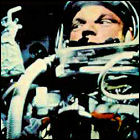 The last living member of the original Mercury astronaut group, former Senator John Glenn, dies at the age of 95. Born in 1921, Glenn was a decorated combat pilot who flew during World War II and the Korean War, before turning his piloting skills to testing experimental aircraft. This brought him to NASA’s attention, and he made the first orbital flight by an American astronaut in 1962. Upon returning from that historic flight, he was removed from NASA’s flight rotation by the request of President Kennedy, who didn’t want to risk the life of a national hero. Glenn then turned to the equally high-stakes world of politics, first running for Congress in 1964, but not winning a Senate seat until 1974. Glenn remained in Congress through 1998, at which point he finally returned to orbit aboard the space shuttle Discovery, the oldest space traveler to have done so.
The last living member of the original Mercury astronaut group, former Senator John Glenn, dies at the age of 95. Born in 1921, Glenn was a decorated combat pilot who flew during World War II and the Korean War, before turning his piloting skills to testing experimental aircraft. This brought him to NASA’s attention, and he made the first orbital flight by an American astronaut in 1962. Upon returning from that historic flight, he was removed from NASA’s flight rotation by the request of President Kennedy, who didn’t want to risk the life of a national hero. Glenn then turned to the equally high-stakes world of politics, first running for Congress in 1964, but not winning a Senate seat until 1974. Glenn remained in Congress through 1998, at which point he finally returned to orbit aboard the space shuttle Discovery, the oldest space traveler to have done so.
Scott Carpenter, Mercury astronaut, dies
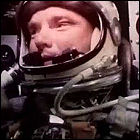 Scott Carpenter, Mercury astronaut and the second American to orbit Earth, dies at the age of 88, having recently suffered a stroke. A decorated military pilot, Carpenter became a test pilot in 1954, and was selected as one of the seven Mercury astronauts in 1959. He became the second American astronaut to orbit Earth by coincidence, as fellow Mercury astronaut Deke Slayton had been grounded by a medical condition, bumping Carpenter up to the pilot of the fourth Mercury flight. That was his only spaceflight, as he retired from NASA in 1967.
Scott Carpenter, Mercury astronaut and the second American to orbit Earth, dies at the age of 88, having recently suffered a stroke. A decorated military pilot, Carpenter became a test pilot in 1954, and was selected as one of the seven Mercury astronauts in 1959. He became the second American astronaut to orbit Earth by coincidence, as fellow Mercury astronaut Deke Slayton had been grounded by a medical condition, bumping Carpenter up to the pilot of the fourth Mercury flight. That was his only spaceflight, as he retired from NASA in 1967.
Wally Schirra, Mercury astronaut, dies
 Astronaut Wally Schirra, one of the seven original Mercury astronauts, and the only astronaut to lift off aboard Mercury, Gemini and Apollo missions, dies at the age of 84. Selected as one of the first “class” of American astronauts, Schirra was the fifth American to fly in space, making six orbits of the Earth in 1962. He commanded Gemini 6, and was the commander of Apollo 7, the first manned Apollo mission, which tested the capabilities of the redesigned Apollo command/service module in Earth orbit. In 1969, he retired from NASA and immediately landed a new gig, sitting aside TV news legend Walter Cronkite for coverage of the missions to the moon, as well as continuing to offer insider commentary on space coverage at CBS through 1975. He was awarded numerous medals by both NASA and the United States Navy, among countless other honors.
Astronaut Wally Schirra, one of the seven original Mercury astronauts, and the only astronaut to lift off aboard Mercury, Gemini and Apollo missions, dies at the age of 84. Selected as one of the first “class” of American astronauts, Schirra was the fifth American to fly in space, making six orbits of the Earth in 1962. He commanded Gemini 6, and was the commander of Apollo 7, the first manned Apollo mission, which tested the capabilities of the redesigned Apollo command/service module in Earth orbit. In 1969, he retired from NASA and immediately landed a new gig, sitting aside TV news legend Walter Cronkite for coverage of the missions to the moon, as well as continuing to offer insider commentary on space coverage at CBS through 1975. He was awarded numerous medals by both NASA and the United States Navy, among countless other honors.
Light This Candle: The Life & Times of Alan Shepard
 Crown Books posthumously publishes Neal Thompson’s non-fictional biography, “Light This Candle: The Life & Times of Alan Shepard“, chronicling the life and career of Alan B. Shepard, the first of the Mercury astronauts to reach space, and the only veteran of the Mercury program to later walk on the moon despite medical issues that nearly ended his spaceflight career.
Crown Books posthumously publishes Neal Thompson’s non-fictional biography, “Light This Candle: The Life & Times of Alan Shepard“, chronicling the life and career of Alan B. Shepard, the first of the Mercury astronauts to reach space, and the only veteran of the Mercury program to later walk on the moon despite medical issues that nearly ended his spaceflight career.
The raising of Liberty Bell 7
 A day short of exactly 38 years since the capsule flew its suborbital flight and then sank as it took on water upon splashdown, Liberty Bell 7, the Mercury capsule flown by Gus Grissom in 1961, is raised from the floor of the Atlantic Ocean from a depth of almost 16,000 feet. The recovery, requiring specialized deep sea equipment, is bankrolled by the Discovery Channel, which gains exclusive broadcast rights to the event. The capsule itself is cleaned up, restored, and put on display at the Kansas Cosmosphere space museum in Hutchinson, Kansas.
A day short of exactly 38 years since the capsule flew its suborbital flight and then sank as it took on water upon splashdown, Liberty Bell 7, the Mercury capsule flown by Gus Grissom in 1961, is raised from the floor of the Atlantic Ocean from a depth of almost 16,000 feet. The recovery, requiring specialized deep sea equipment, is bankrolled by the Discovery Channel, which gains exclusive broadcast rights to the event. The capsule itself is cleaned up, restored, and put on display at the Kansas Cosmosphere space museum in Hutchinson, Kansas.
Deke! U.S. Manned Space From Mercury to the Shuttle
 Forge Books posthumously publishes astronaut Deke Slayton’s non-fictional memoir of his time in NASA, “Deke! U.S. Manned Space From Mercury to the Shuttle“, co-written with Michael Cassutt. The book details Slayton’s selection to the Mercury ground and his subsequent medical grounding, his time in charge of NASA’s astronaut office, and his eventual flight aboard the international Apollo-Soyuz Test Project mission.
Forge Books posthumously publishes astronaut Deke Slayton’s non-fictional memoir of his time in NASA, “Deke! U.S. Manned Space From Mercury to the Shuttle“, co-written with Michael Cassutt. The book details Slayton’s selection to the Mercury ground and his subsequent medical grounding, his time in charge of NASA’s astronaut office, and his eventual flight aboard the international Apollo-Soyuz Test Project mission.
Mercury 9
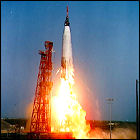 The final manned Mercury flight, Mercury 9 (nicknamed Faith 7) puts astronaut Gordon Cooper in orbit for over a day. Over the course of 34 hours, Cooper circles Earth 22 times, performing small-scale experiments and photography tasks. With Mercury astronaut Deke Slayton grounded due to health issues, only six of the Mercury seven have flown. Development of a two-seater descendant of the Mercury design (initially called “Big Mercury” but now known as Gemini) is well underway, along with the development of the Apollo spacecraft that will succeed Gemini and take men to the moon. Cooper is the last solo American space pilot until Mike Melvill flies the experimental SpaceShip One into suborbital space in the 21st century.
The final manned Mercury flight, Mercury 9 (nicknamed Faith 7) puts astronaut Gordon Cooper in orbit for over a day. Over the course of 34 hours, Cooper circles Earth 22 times, performing small-scale experiments and photography tasks. With Mercury astronaut Deke Slayton grounded due to health issues, only six of the Mercury seven have flown. Development of a two-seater descendant of the Mercury design (initially called “Big Mercury” but now known as Gemini) is well underway, along with the development of the Apollo spacecraft that will succeed Gemini and take men to the moon. Cooper is the last solo American space pilot until Mike Melvill flies the experimental SpaceShip One into suborbital space in the 21st century.
Mercury 8
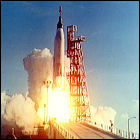 Astronaut Wally Schirra is the third American to orbit Earth, aboard the Mercury 8 capsule (nicknamed Sigma 7). He remains in orbit for just over nine hours in the cramped quarters of the Mercury spacecraft before splashing down.
Astronaut Wally Schirra is the third American to orbit Earth, aboard the Mercury 8 capsule (nicknamed Sigma 7). He remains in orbit for just over nine hours in the cramped quarters of the Mercury spacecraft before splashing down.
Mercury 7
 The second American orbital flight is launched, with Scott Carpenter lifting off aboard Mercury 7 (nicknamed Aurora 7). Carpenter’s five-hour, three-orbit mission is almost a carbon copy of John Glenn’s orbital flight, the primary goal being to duplicate the flight and compare the two astronauts’ reports and reactions.
The second American orbital flight is launched, with Scott Carpenter lifting off aboard Mercury 7 (nicknamed Aurora 7). Carpenter’s five-hour, three-orbit mission is almost a carbon copy of John Glenn’s orbital flight, the primary goal being to duplicate the flight and compare the two astronauts’ reports and reactions.
Mercury 6: first American in orbit
 The third manned Mercury flight, Friendship 7, puts John Glenn in orbit for nearly five hours, the first American astronaut to circle the Earth. The retro-rocket package on Glenn’s vehicle, Friendship 7, becomes an issue when a sensor indicates that the heat shield protecting the capsule’s interior from the intense heat of reentry has slipped. Intended to be cast off before reentry, the retro package is left on at the insistence of ground controllers, resulting in an unusually rough ride home after only three orbits.
The third manned Mercury flight, Friendship 7, puts John Glenn in orbit for nearly five hours, the first American astronaut to circle the Earth. The retro-rocket package on Glenn’s vehicle, Friendship 7, becomes an issue when a sensor indicates that the heat shield protecting the capsule’s interior from the intense heat of reentry has slipped. Intended to be cast off before reentry, the retro package is left on at the insistence of ground controllers, resulting in an unusually rough ride home after only three orbits.
Mercury 5: first American monkey in orbit
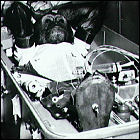 Prior to putting an astronaut in orbit, NASA launches a chimpanzee named Enos on a two-orbit Mercury flight to validate the survivability of the spacecraft for an extended flight. Enos is recalled to Earth when both his spacesuit and his Mercury capsule begins heating up unexpectedly, and attitude control is lost; after three hours and two orbits, Mercury 5 returns to Earth. While hauling the capsule from the ocean, recovery crews accidentally crack the window. Despite all this, Enos is safely returned home; he dies a year later from an illness not related to his orbital flight.
Prior to putting an astronaut in orbit, NASA launches a chimpanzee named Enos on a two-orbit Mercury flight to validate the survivability of the spacecraft for an extended flight. Enos is recalled to Earth when both his spacesuit and his Mercury capsule begins heating up unexpectedly, and attitude control is lost; after three hours and two orbits, Mercury 5 returns to Earth. While hauling the capsule from the ocean, recovery crews accidentally crack the window. Despite all this, Enos is safely returned home; he dies a year later from an illness not related to his orbital flight.
Mercury 4: a sinking feeling
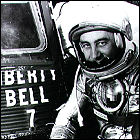 The second American in space is Virgil “Gus” Grissom, pilot of the Mercury 4 capsule Liberty Bell 7. Like Alan Shepard’s flight, Grissom’s launch reaches an altitute of 118 miles and splashes down 15 minutes later, but mechanical problems with the explosive bolts to release the capsule’s hatch allow water into the vehicle. Grissom has to bail out at sea, wearing a spacesuit that’s rapidly taking on water, while Liberty Bell 7 sinks to the bottom of the Atlantic. Grissom weathers repeated accusations that he manually blew the hatch and caused his vehicle to sink, a claim which is later disproven.
The second American in space is Virgil “Gus” Grissom, pilot of the Mercury 4 capsule Liberty Bell 7. Like Alan Shepard’s flight, Grissom’s launch reaches an altitute of 118 miles and splashes down 15 minutes later, but mechanical problems with the explosive bolts to release the capsule’s hatch allow water into the vehicle. Grissom has to bail out at sea, wearing a spacesuit that’s rapidly taking on water, while Liberty Bell 7 sinks to the bottom of the Atlantic. Grissom weathers repeated accusations that he manually blew the hatch and caused his vehicle to sink, a claim which is later disproven.
Mercury 3: first American in space
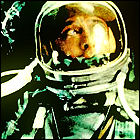 Alan B. Shepard, aboard the Freedom 7 Mercury capsule, becomes the first American in space when he is launched on a fifteen-minute suborbital flight from Cape Canaveral, splashing down in the Atlantic Ocean. The Mercury spacecraft offers its pilot more maneuverability than the Soviet Vostok vehicle, which is almost entirely controlled from the ground.
Alan B. Shepard, aboard the Freedom 7 Mercury capsule, becomes the first American in space when he is launched on a fifteen-minute suborbital flight from Cape Canaveral, splashing down in the Atlantic Ocean. The Mercury spacecraft offers its pilot more maneuverability than the Soviet Vostok vehicle, which is almost entirely controlled from the ground.
Mercury 2: canned Ham
 The first living creature to reach space aboard an American rocket is Ham, a chimpanzee wired with electrodes and sensors to determine the effects of space travel on a higher primate whose body might react similarly to that of a human being. NASA sends Ham on the sixteen-minute suborbital Mercury 2 flight, ending in a splashdown in the Atlantic. Both Ham and his vehicle survive the flight despite numerous equipment glitches in both the Redstone rocket and the Mercury capsule itself (which actually blasts away from the Redstone via its launch abort system), which loses cabin pressure (fortunately, Ham has his own spacesuit to protect him) and then puts its primate pilot through a punishing 17G reentry. For his pioneering feat of spaceflight, Ham receives an apple, an orange, and paid retirement to the National Zoo.
The first living creature to reach space aboard an American rocket is Ham, a chimpanzee wired with electrodes and sensors to determine the effects of space travel on a higher primate whose body might react similarly to that of a human being. NASA sends Ham on the sixteen-minute suborbital Mercury 2 flight, ending in a splashdown in the Atlantic. Both Ham and his vehicle survive the flight despite numerous equipment glitches in both the Redstone rocket and the Mercury capsule itself (which actually blasts away from the Redstone via its launch abort system), which loses cabin pressure (fortunately, Ham has his own spacesuit to protect him) and then puts its primate pilot through a punishing 17G reentry. For his pioneering feat of spaceflight, Ham receives an apple, an orange, and paid retirement to the National Zoo.
Project Mercury
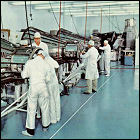 The newly-formed NASA reveals a bold plan: Project Mercury will be an extensive program to create a vehicle capable of safely sending men into Earth orbit and returning them in one piece. The rigorous selection process to find the country’s first space pilots – astronauts – begins, focusing on combat pilots and especially test pilots with experience in flying unproven experimental aircraft (the Mercury spacecraft will definitely qualify for this description).
The newly-formed NASA reveals a bold plan: Project Mercury will be an extensive program to create a vehicle capable of safely sending men into Earth orbit and returning them in one piece. The rigorous selection process to find the country’s first space pilots – astronauts – begins, focusing on combat pilots and especially test pilots with experience in flying unproven experimental aircraft (the Mercury spacecraft will definitely qualify for this description).